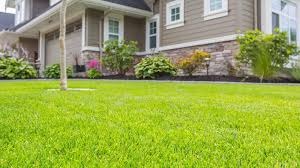Healthy Lawn Solutions: How To Grow The Greenest Grass On The Block
Every homeowner desires a lush lawn that is green and beautiful. The grass you want to envy requires more than random fertilizer and occasional watering. You need a combination of smart practices, constant care, and support. If you want the greenest grass in your neighborhood, these healthy lawn solutions are the best way to get there.
1. Soil Health
A healthy lawn starts below the surface. Healthy soil is full of nutrients, has a solid structure, and promotes root growth. A soil test is the first step to changing your lawn maintenance routine. This will give you the pH value and allow you to determine what amendments you need for your yard.
Treating your soil according to its pH, alkalinity, and the lack of key nutrients like phosphorus or nitrogen will help you achieve long-term grass success. Compost or organic material can also increase microbial growth, improve drainage, and promote a robust root system.
2. Choose the right grass type for your region
Not all Grasses can thrive in similar conditions. The best grass to grow in your area depends on the climate, sunlight exposure, and soil type. Cool-season fescues and Kentucky Bluegrass grow well in northern areas, while warm-season varieties of Bermuda or Zoysia thrive in southern climates.
Consulting a local specialist or extension service will ensure you use the right grass type for your location. With the right match, your lawn is less stressed and requires fewer resources to keep it green.
3. Master the Mowing Routine
Correct mowing techniques are one of the easiest ways to keep your lawn healthy. You should avoid cutting your lawn too short, which weakens the root system and encourages weeds. Cut no more than a third at a single time.
Keep your mower’s blades sharp. This will prevent you from tearing up the grass, which can leave it susceptible to disease. Alternate your mowing pattern to avoid soil compaction.
4. Water Deeply but Not Frequently
Watering practices can make a major difference to the health of your grass. Avoid frequent shallow watering and opt for more frequent but deeper irrigation. This encourages your roots to grow deep into the soil, making your lawn drought—and disease-resistant.
Early morning watering is ideal, as it minimizes evaporation. It also allows the lawn enough time to dry by nightfall. In general, most lawns will need around one inch of water per week, including rain.
5. Feeding a Lawn for a Reason
Fertilizing your lawn is essential, but the timing and formula are also important. Over-fertilizing could burn your lawn, and excessive growth can make it vulnerable to pests or disease. Under-fertilizing will cause your lawn to thin and yellow.
Use a slow-release nitrogen-rich fertiliser appropriate for your grass species and region. It is best to apply the fertilizer in spring or fall for grasses that grow during cool seasons, and late spring into summer for varieties that grow during warm seasons.
6. As needed, aerate and dethatch
Compacted soil and thatch (the organic matter that accumulates between the soil layer and the grass) can prevent water from reaching the grass’s roots. Aeration—removing small bits of soil—loosens compacted soil and allows air and nutrients to move freely in it.
Dethatching involves removing the thick organic buildup that suffocates grass. Both tasks can be performed in the spring and fall. They support strong root growth and better nutrient intake.
7. Control Weeds Naturally
Weeds can be unsightly but compete for water, nutrients, and sunlight with your grass. For weed control, use integrated weed prevention rather than chemical herbicides. These can cause harm to beneficial organisms.
Weeds will naturally be pushed out of the way by a healthy, dense turf. You can get good results by hand-pulling weeds, using spot treatments, or applying corn gluten meal as a natural preemergent. Mulching edges or planting ground cover in bare places can help reduce weed growth.
Conclusion
It is not just about quick fixes. You need to provide the best conditions for your grass to thrive. The health of a lawn depends on every step, including soil preparation, proper watering, fertilization, and mowing.
If you follow these healthy lawn solutions, you will not only boost your curbside appeal but also create an environmentally friendly yard in which you can take great pride season after season.
READ MORE : The Importance of Proper Roof Ventilation for Canton Homes

